Jaisalmer, Rajasthan
Been there recently?
A trading centre and a princely state, it was established around the 12th century in Rajasthan. The Thar Desert is located at its centre. Because of the yellow sandstone used in its construction, Jaisalmer is also known as the “Golden City.” The Maharaja’s Palace and exquisitely constructed Jain temples are located behind the walls of the Jaisalmer Fort, a hilltop citadel that is famous throughout the world. The historic havelis (homes) that are still in use, along with the shops and hotels, are what make it unique. This enchanted city is known for its rolling hills of honey-hued sand dunes, vast barren expanses, contrasting colours, and mesmerising historical treasures. The Jaisalmer Fort, which is still inhabited, rises out of the desert like a mirage and appears ablaze as the sun’s golden rays bathe it. Its strategic position on major ancient trade routes brought in opulent wealth, which in turn inspired lavish architectural styles. It is renowned for its wood carvings, regional artistry, incredibly rich performing arts, and cultural heritage.
Nearby Places to See
Sam Sand Dunes
The sand dunes, which are about 35 kilometres outside of town, attract over a million visitors annually. Extending for around 3–4 kilometres, they provide a breathtaking panorama and an opportunity to experience the desert landscape up close. The adrenaline rush is amped up with nighttime camping, a camel safari, or a Jeep safari.
The sand dunes, which are about 35 kilometres outside of town, attract over a million visitors annually. Extending for around 3–4 kilometres, they provide a breathtaking panorama and an opportunity to experience the desert landscape up close. The adrenaline rush is amped up with nighttime camping, a camel safari, or a Jeep safari.


Khuri
It takes 45 kilometres to reach the village of Khuri from the city of Jaisalmer. Tourists can stay in quaint, old-fashioned houses. Smack dab in the middle of the Thar desert, it is the place to go for a taste of rural life and cuisine despite a lack of modern conveniences. It is a unique and memorable experience to sleep in one of the traditional huts, which are either square or round and have thatched roofs.
It takes 45 kilometres to reach the village of Khuri from the city of Jaisalmer. Tourists can stay in quaint, old-fashioned houses. Smack dab in the middle of the Thar desert, it is the place to go for a taste of rural life and cuisine despite a lack of modern conveniences. It is a unique and memorable experience to sleep in one of the traditional huts, which are either square or round and have thatched roofs.
Lodhruva
The deserted ruins of Lodhruva, which are located outside of Jaisalmer, are renowned for a Jain temple and a Kalp Vriksh, the wishing tree. Parshwanath, the 23rd tirthankar (saint), is honoured at this shrine. Each intricately carved stone used in the construction of the temple displays the temple’s exquisite architectural beauty. The complex has been restored to its original, pristine condition after extensive repairs and restorative work were carried out over the years.
The deserted ruins of Lodhruva, which are located outside of Jaisalmer, are renowned for a Jain temple and a Kalp Vriksh, the wishing tree. Parshwanath, the 23rd tirthankar (saint), is honoured at this shrine. Each intricately carved stone used in the construction of the temple displays the temple’s exquisite architectural beauty. The complex has been restored to its original, pristine condition after extensive repairs and restorative work were carried out over the years.
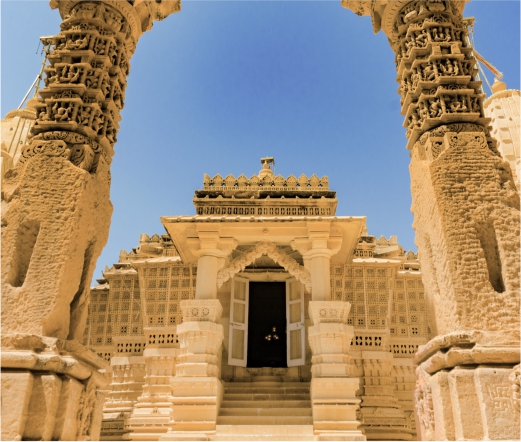
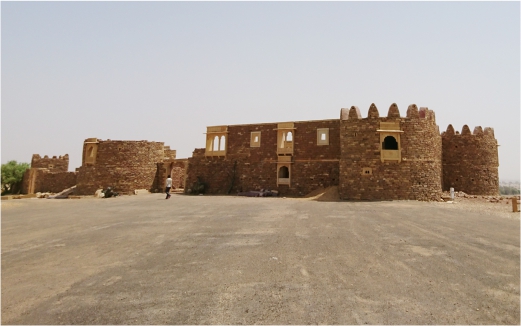
Khaba Fort
This deserted fort can be found in the Khaba village, 26 kilometres from Jaisalmer, in the Thar region. It is believed that the fort was built sometime around the 13th century. As such, it serves as an entry point to the long-abandoned village of Kuldhara, whose last inhabitants left in the 19th century. The fort houses a small museum with interesting artefacts.
This deserted fort can be found in the Khaba village, 26 kilometres from Jaisalmer, in the Thar region. It is believed that the fort was built sometime around the 13th century. As such, it serves as an entry point to the long-abandoned village of Kuldhara, whose last inhabitants left in the 19th century. The fort houses a small museum with interesting artefacts.
Jaisalmer Fort
The Jaisalmer Fort, a magnificent construction made of yellow sandstone, is the centre of attention in the vibrant Thar Desert. This massive fort, perched atop the Trikuta Hill (a hill with three peaks), appears to emerge from the desert, and the gleaming stone façade gives the impression that it is a continuation of the magnificent Thar. The best time to experience the magic of this architectural wonder is at sunset, when the entire fort appears to be ablaze as it reflects the light from the setting sun, earning it a place on the list of UNESCO World Heritage Sites.
The Jaisalmer Fort, a magnificent construction made of yellow sandstone, is the centre of attention in the vibrant Thar Desert. This massive fort, perched atop the Trikuta Hill (a hill with three peaks), appears to emerge from the desert, and the gleaming stone façade gives the impression that it is a continuation of the magnificent Thar. The best time to experience the magic of this architectural wonder is at sunset, when the entire fort appears to be ablaze as it reflects the light from the setting sun, earning it a place on the list of UNESCO World Heritage Sites.
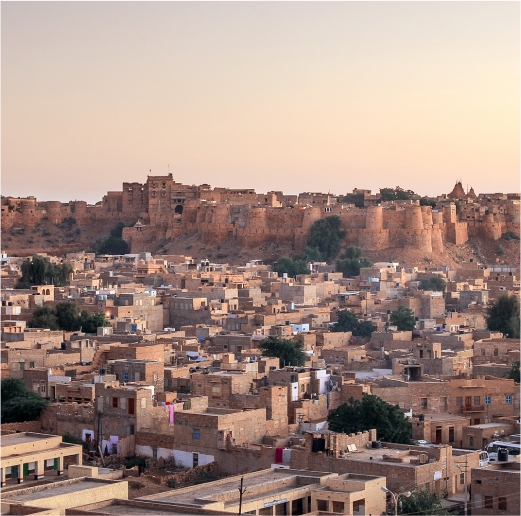

Gadsisar Lake
The Gadsisar rainwater lake is a popular picnic spot due to its cool and scenic surroundings. It offers a fantastic vantage point from which to view the magnificent Jaisalmer Fort when it is bathed in the glorious tones of the rising sun. The lake, which is located just outside the city limits, used to serve as the only water storage facility for the parched city of Jasialmer. Tilon-ki-Pol, a gorgeously carved yellow stone archway that stands at the lake’s entrance, is situated in the southern region of the city. Contrary to popular belief, it is not an oasis but a water conservation tank, built around 1400 AD by the then maharaja of Jaisalmer, Maharwal Gadsi Singh.
The Gadsisar rainwater lake is a popular picnic spot due to its cool and scenic surroundings. It offers a fantastic vantage point from which to view the magnificent Jaisalmer Fort when it is bathed in the glorious tones of the rising sun. The lake, which is located just outside the city limits, used to serve as the only water storage facility for the parched city of Jasialmer. Tilon-ki-Pol, a gorgeously carved yellow stone archway that stands at the lake’s entrance, is situated in the southern region of the city. Contrary to popular belief, it is not an oasis but a water conservation tank, built around 1400 AD by the then maharaja of Jaisalmer, Maharwal Gadsi Singh.
Patwon Ki Haveli
The magnificent Patwon-ki-haveli, known for its lovely paintings, intricate carvings, and grandiose style of architecture, is located in the winding streets of Jaisalmer’s main city. The entire complex is actually a cluster of five beautiful smaller havelis, rather than a single large haveli. The interior walls of this grand mansion are decorated with paintings and mirror artwork. One of the sections has been transformed into a museum, which is home to a number of early 19th-century artefacts, in order to cater to tourists who are interested in the area’s rich cultural history. Every arch in this haveli has a unique theme and individual depictions that showcase the craftsmanship and aesthetic talent of the local Rajasthani craftsmen.
The magnificent Patwon-ki-haveli, known for its lovely paintings, intricate carvings, and grandiose style of architecture, is located in the winding streets of Jaisalmer’s main city. The entire complex is actually a cluster of five beautiful smaller havelis, rather than a single large haveli. The interior walls of this grand mansion are decorated with paintings and mirror artwork. One of the sections has been transformed into a museum, which is home to a number of early 19th-century artefacts, in order to cater to tourists who are interested in the area’s rich cultural history. Every arch in this haveli has a unique theme and individual depictions that showcase the craftsmanship and aesthetic talent of the local Rajasthani craftsmen.
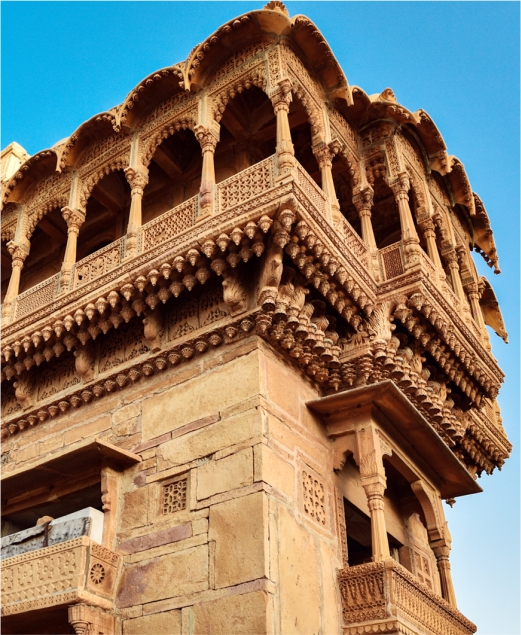
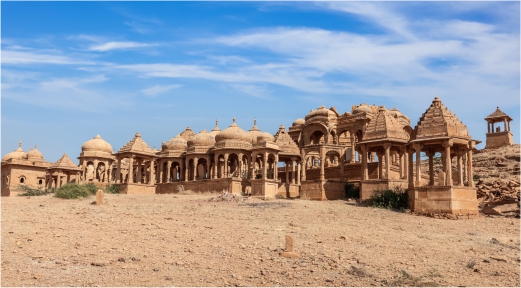
Bada Bagh
It is a cenotaph garden that is about 6 kilometres from Jaisalmer. As the name implies, there used to be a sizable garden surrounding the cenotaphs, but it has since disappeared. Built between the 17th and 19th centuries, these tomb-like structures are known locally as “Chhatris” (Umbrella).v
It is a cenotaph garden that is about 6 kilometres from Jaisalmer. As the name implies, there used to be a sizable garden surrounding the cenotaphs, but it has since disappeared. Built between the 17th and 19th centuries, these tomb-like structures are known locally as “Chhatris” (Umbrella).v

-
Destination



